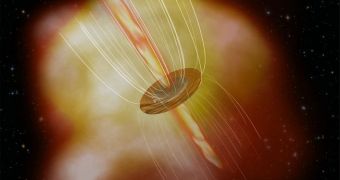Scientists at the Bonn University, in Germany, announce that preliminary results from their telescopes studies aimed at massive stars reveal that magnetic fields play a much more important in regulating these fireballs' growth than previously thought. The investigation was conducted using the Jodrell Bank Observatory-based MERLIN radio telescope network. The scientists looked at what happens in and around massive stars, as these structures developed, and sought to find which factors have the most influence in the processes. The study was led by BU expert astronomer Dr. Wouter Vlemmings.
This is not the first time that the influence of magnetic fields on stars was gaged in a study. Astrophysicists already know for example that smaller stars, including yellow dwarfs such as our Sun, are heavily controlled by these fields, but the German investigators were interested in seeing if the same applied to massive stars as well. These objects are very large, and they can reach several hundred times the mass of our own Sun. Details of the research appear in the February issue of the highly-regarded scientific journal Monthly Notices of the Royal Astronomical Society.
What the new work basically suggests is that normal star formation may have much more in common with massive star generation than previously thought. This is a very important shift in view. Until now, most astronomers and astrophysicists believed that the role played by magnetic fields was a lot more reduced than the one played for instance by radiation and turbulence. Figuring out how much each of these processes contributes is extremely important, as massive stars are responsible for iron production, as well as for circulating matter in the galaxy.
“While magnetic fields have been observed in the clouds of molecular hydrogen from which stars form, observations close to massive stars have up to now been in short supply. If the formation of massive stars is similar to their lighter counterparts, we should be able to detect the strong magnetic fields needed to both produce the jets and stabilize the disks associated with them,” PhysOrg quotes Vlemmings as saying. The expert and his team basically found 3D magnetic fields at work in the disk surrounding the Cepheus A HW2 proto-massive star. The object is some 2,300 light-years away.

 14 DAY TRIAL //
14 DAY TRIAL //